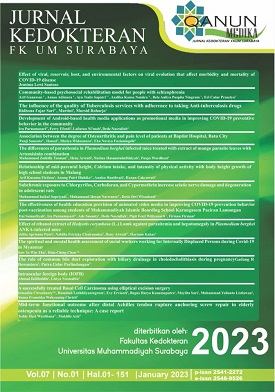Intraocular foreign body (IOFB)
Abstract
Intraocular foreign bodies (IOFBs) were 16-40% of open globe trauma and could cause severe visual loss. Therefore, they require immediate diagnosis and treatment. This is a case of an 18-year-old man who came to the hospital complaining of a metal piercing in his left eye while cutting some metal about 2 hours before entering the hospital. On ophthalmologic examination, visual acuity of the left eye was 3/60, and a full-thickness laceration of the cornea with an IOFB was seen at the anterior chamber base. Immediate IOFB evacuation was carried out on the same day as the incident happened. During the operation, a metal intraocular foreign body with a sharp tip, 4x2x1 mm in size, was successfully removed in intact condition. Next, the laceration and the corneal limbus incision were sutured using 10.0 nylon. The stitches are tight, and the anterior chamber depth is maintained. Evaluation on the fourth week after IOFB evacuation showed that visual acuity in the left eye was 6/20 with lens correction C-1.50 x 150° become 6/7.5. Appropriate and prompt diagnosis and management of open eye injury can contribute to preserving a good anatomical and functional result.
Full text article
References
Cosar, B., Osman, C., Totan, Y., Seyhan, O., & Zileliog, O. (1999). Vitrectomy , foreign-body extraction , and intraocular lens implantation. Combined Phacoemulsification, Vitrectomy, Foreign-Body Extraction, and Intraocular Lens Implantation.
Dinardo, A., & Boncher, T. (2012). The Pharmacist’s Role in Managing Pain r, B., Osman, C., Totan, Y., Seyhan, O., & Zileliog, O. (1999). Vitrectomy , foreign-body extraction , and intraocular lens implantation. Combined Phacoemulsification, Vitrectomy, Foreign-Body Extraction, and Intraocular Lens Implantation.
Dinardo, A., & Boncher, T. (2012). The Pharmacist’s Role in Managing Pain Associated With Ocular Trauma. The Pharmacist’s Resource for Clinical Excellence. https://www.uspharmacist.com/article/the-pharmacists-role-in-managing-pain-associated-with-ocular-trauma
Erakgun, T., & Egrilmez, S. (2008). Prognostic factors in vitrectomy for posterior segment intraocular foreign bodies. Journal of Trauma - Injury, Infection and Critical Care, 64(4), 1034–1037. https://doi.org/10.1097/TA.0b013e318047dff4
Flach, A. J., & Fraunfelder, F. W. (2019). Obat-Obat Mata. In P. Riordan-Eva & J. P. Whitcher (Eds.), Vaughan & Asbury’s General Ophthalmology (17th ed.). Penerbit Buku Kedokteran EGC.
Jung, H. C., Lee, S. Y., Yoon, C. K., Park, U. C., Heo, J. W., & Lee, E. K. (2021). Intraocular Foreign Body : Diagnostic Protocols and Treatment Strategies in Ocular Trauma Patients.
Katzung, B. G., & Trevor, A. J. (2015). Basic & Clinical Pharmacology. McGraw-Hill.
Kuhn, F., Morris, R., Witherspoon, C. D., & Mester, V. (2004). Birmingham Eye Trauma Terminology system (BETT). Journal Francais d’Ophtalmologie, 27(2), 206–210. https://doi.org/10.1016/S0181-5512(04)96122-0
Lit, E. S., & Young, L. H. Y. (2002). Anterior and posterior segment intraocular foreign bodies. International Ophthalmology Clinics, 42(3), 107–120. https://doi.org/10.1097/00004397-200207000-00013
Liu, C. C. H., Tong, J. M. K., Li, P. S. H., & Li, K. K. W. (2017). Epidemiology and clinical outcome of intraocular foreign bodies in Hong Kong: a 13-year review. International Ophthalmology, 37(1), 55–61. https://doi.org/10.1007/s10792-016-0225-4
Parke, D. W., Flynn, H. W., & Fisher, Y. L. (2013). Management of intraocular foreign bodies:aclinical flight plan. Canadian Journal of Ophthalmology, 48(1), 8–12. https://doi.org/10.1016/j.jcjo.2012.11.005
Patel, S. N., Langer, P. D., Zarbin, M. A., & Bhagat, N. (2012). Diagnostic value of clinical examination and radiographic imaging in identification of intraocular foreign bodies in open globe injury. European Journal of Ophthalmology, 22(2), 259–268. https://doi.org/10.5301/EJO.2011.8347
Suhardjo, & Agni, A. N. (2017). Buku Ilmu Kesehatan Mata (3rd ed.). Departemen Ilmu Kesehatan Mata Fakultas Kedokteran UGM Yogyakarta.
Virgana, R., & Widyanatha, M. I. (2021). Management of Posterior Intraocular Foreign Body, A Case Series (Issue 3507). https://doi.org/10.46883/onc.3507
Wulan, M., Sari, P., Sovani, I., Sjamsulaksan Kartasasmita, A., Iskandar, E., Virgana, R., & Ihsan, G. (2018). Intraocular Foreign Body: a Case Series. 2(1), 33–42. https://www.inavrs.org/
Yan, H., Wang, J., You, C., & Meng, X. (2016). Intraocular foreign bodies. Mechanical Ocular Trauma: Current Consensus and Controversy, 15, 49–67. https://doi.org/10.1007/978-981-10-2150-3_4
Yeh, S., Colyer, M. H., & Weichel, E. D. (2008). Current trends in the management of intraocular foreign bodies. Current Opinion in Ophthalmology, 19(3), 225–233. https://doi.org/10.1097/ICU.0b013e3282fa75f1
Authors

Qanun Medika by FK UM Surabaya is liscence under Lisensi Creative Commons Atribusi 4.0 Internasional.

